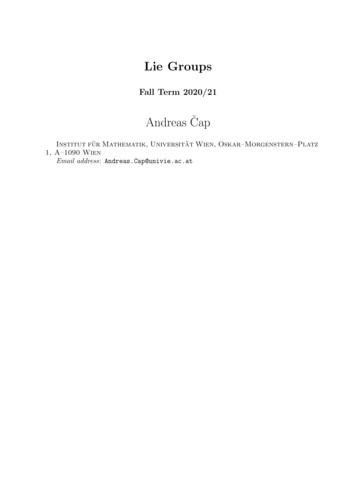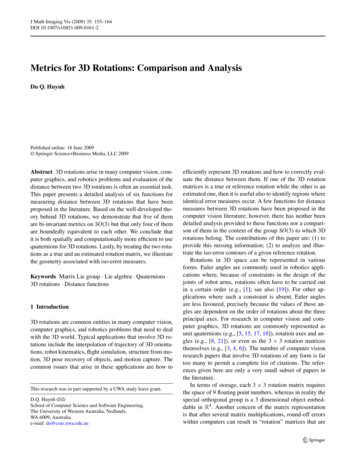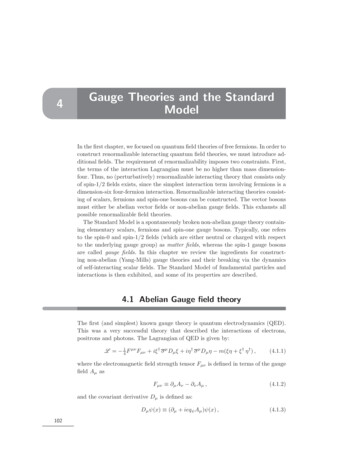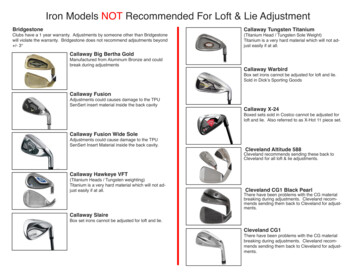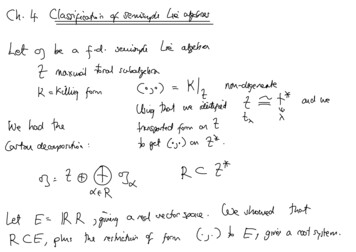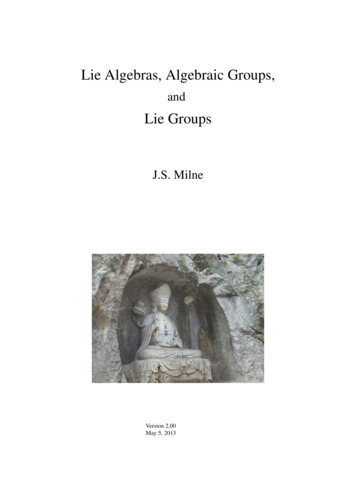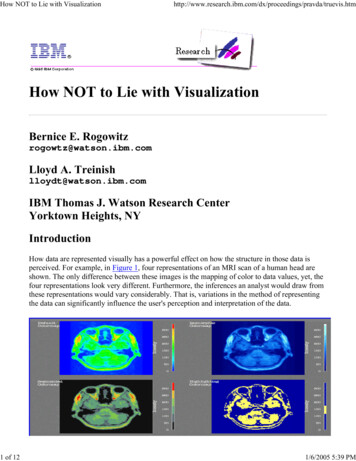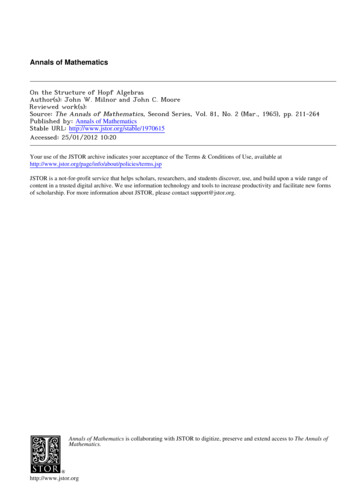
Transcription
Lie GroupsRichard BorcherdsMay 25, 2012AbstractThese are preliminary rather scrappy notes that have not yet beenproofread. Many of the sections, especially the latter ones, are still incomplete, contain many errors, and need a lot of further work. You have beenwarned. For updated versions go to http://math.berkeley.edu/ reb.These are notes for a Lie Groups course Math 261AB, 2011-2012. Thecourse philosophy is that this is a service course, so I will emphasizeapplications of Lie groups to other areas, and will concentrate more ondiscussing examples than on giving complete proofs. Some of the sectionsare based on some lectures I gave a few years ago, and I have used theTeX files of notes for these lectures written by Hanh Duc Do, An Huang,Santiago Canez, Lilit Martirosyan, Emily Peters, Martin Vito-Cruz, Anton Geraschenko (many of whose TeX macros I have reused), and SevakMkrtchyan.Contents1ExamplesA typical example of a Lie group is the group GL2 (R) of invertible 2 by 2matrices, and a Lie group is defined to be something that resembles this. Itskey properties are that it is a smooth manifold and a group and these structuresare compatible. So we define a Lie group to be a smooth manifold that is also agroup, such that the product and inverse are smooth maps. All manifolds willbe smooth and metrizable unless otherwise stated.We start by trying to list all Lie groups.Example 1 Any discrete group is a 0-dimensional Lie group.This already shows that listing all Lie groups is hopeless, as there are toomany discrete groups. However we can split a Lie group into two: the componentof the identity is a connected normal subgroup, and the quotient is discrete.Although a complete description of the discrete part is hopeless, we can goquite far towards classifying the connected Lie groups.Example 2 The real numbers under addition are a 1-dimensional commutativeLie group. Similarly so is any finite dimensional real vector space under addition.1
Example 3 The circle group S 1 of all complex numbers of absolute value 1 isa Lie group, also abelian.We have essentially found all the connected abelian Lie groups: they areproducts of copies of the circle and the real numbers. For example, the nonzero complex numbers form a Lie group, which (via the exponential map andpolar decomposition) is isomorphic to the product of a circle and the reals.Example 4 The general linear group GLn (R) is the archetypal example of anon-commutative Lie group. This has 2 components as the determinant can bepositive or negative. Similarly we can take the complex general linear group.The classical groups are roughly the subgroups of general linear groups thatpreserve bilinear or hermitian forms. The compact orthogonal groups On (R)preserve a positive definite symmetric bilinear form on a real vector space. Wedo not have to restrict to positiver definite forms: in special relativity we getthe Lorentz group O1,3 (R) preserving an indefinite form. The symplectic groupSp2n (R) preserves a symplectic form and is not compact. The unitary groupUn preserves a hermitian form on C n and is compact as it is a closed subgroupof the orthogonal group on R2n . Again we do not have to restrict to positivedefinite Hermitian forms, and there are non-compact groups Um,n preserving2 z1 2 · · · zm 2 zm 1 ···.There are many variations of these groups obtained by tweaking abeliangroups at the top and bottom. We can kill off the abelian group at the topof many of them by taking matrices of determinant 1: this gives special linear,special orthogonal r groups and so on. (“Special” usually means determinant1). Alternatively we can make the abelian group at the top bigger: the generalsymplectic group GSp is the group of matrices that multiply a symplectic formby a non-zero constant. We can also kill off the abelian group at the bottom(often the center) by quotienting out by it: this gives projective general lineargroups and so on. (The word “projective” usually means quotient out by thecenter, and comes from the fact that the projective general linear group actson projective space.) Finally we can make the center bigger by taking a centralextension. For example, the spin groups are double covers of the special orthogonal groups. The spin group double cover of SO3 (R) can be constructed usingquaternions.Exercise 5 If z a bi cj dk is a quaternionshow that zz is real, where z a bi cj dk. Show that z 7 z zz is a homomorphism of groupsfrom non-zero quaternions to positive reals. Show that the quaternions forma division ring; in other words check that every non-zero quaternion has aninverse.Exercise 6 Identify R3 with the set of imaginary quaternions bi cj dk.Show that the group of unit quaternions S 3 acts on this by conjugation, andgives a homomorphism S 3 7 SO3 (R) whose kernel has order 2.A typical example of a solvable Lie group is the group of upper triangularmatrices with nonzero determinant. (Recall that solvable means the group canbe split into abelian groups.) It has a subgroup consisting of matrices with 1son the diagonal: this is a typical example of a nilpotent Lie group. (Nilpotent2
means that if we keep killing the center we eventually kill the whole group. Wewill see later that a connected Lie group is nilpotent if all elements of its liealgebra are nilpotent matrices: this is where the name “nilpotent” comes from.) 1 . Gsol Gnil 1 1 00Exercise 7 Check that these groups are indeed solvable and nilpotent.Exercise 8 Show that any finite group of prime-power order pn is nilpotent,and find a non-abelian example of order p3 for any prime p. (Hint: show thatany conjugacy class not in the center has order divisible by p, and deduce thatthe center has order divisible by p unless the group is trivial.)Exercise 9 The Moebius group consists of all isomorphisms from the complexunit disk to itself: z 7 (az b)/(cz d) with ad bc 1, a d, b c.Show that this is the group P SU1,1 . Similarly show that the group of conformaltransformations of the upper half plane is P SL2 (R). Since the upper half planeis isomorphic to the unit disc, we see that the groups P SU1,1 and P SL2 (R) areisomorphic. This illustrates one of the confusing things about Lie groups: thereare a bewildering number of unexpected isomorphisms between them in smalldimensions.Exercise 10 Show that there is a (nontrivial!) homomorphism from SL2 (R) tothe group O2,1 (R), and find the image and kernel. (Consider the action of thegroup SL2 (R) on the 3-dimensional symmetric square S 2 (R2 ) and show thatthis action preserves a quadratic form of signature (2, 1).)Klein claimed at one point that geometry should be identified with grouptheory: a geometry is determined by its group of symmetries. (This fails forRiemannian geometry.) For example, affine geometry consists of the propertiesof space invariant under the group of affine transformations, projective geometryis properties of projective space invariant under projective transformations, andso on. The group of affine transformations in n dimensions is a semidirectproduct Rn .GLn (R). This can be identified with the subgroup of GLn 1 fixing avector (sometimes called the mirabolic subgroup). For example, in 1-dimensionwe get a non-abelian 2-dimensional Lie group of transformations x 7 ax bwith a 6 0.What does a general Lie group look like? In general, a Lie group G can bebroken up into a number of pieces as follows.As we mentioned earlier,the connected component of the identity, Gconn G,is a normal subgroup, and G/Gconn is a discrete group.1 Gconn G Gdiscrete 1so this breaks up a Lie group into a connected subgroup and a discrete quotient.The maximal connected normal solvable subgroup of Gconn is called the solvable radical Gsol . Recall that a group is solvable if there is a chain of subgroups3
Gsol · · · 1, where consecutive quotients are abelian. Lie’s theorem tellsus that some cover of Gsol is isomorphic to a subgroup of the group of uppertriangular matrices.Since Gsol is solvable, Gnil : [Gsol , Gsol ] is nilpotent, i.e. there is a chainof subgroups Gnil G1 · · · Gk 1 such that Gi /Gi 1 is in the center ofGnil /Gi 1 . In fact, Gnil must be isomorphic to a subgroup of the group of uppertriangular matrices with ones on the diagonal. Such a group is called unipotent.Every normal solvable subgroup of Gconn /Gsol is discrete, and therefore inthe center (which is itself discrete). We call the pre-image of the center G .Then G/G is a product of simple groups (groups with no normal subgroups).So a general Lie group has a chain of normal subgroups that are trivial,nilpotent, solvable, connected, or the whole group, such that the quotientsare nilpotent, abelian, almost a product of simple groups, and discrete.Example 11 Let G be the group of all shape-preserving transformations ofR4 (i.e. translations, reflections, rotations, and scaling). It is sometimes calledR4 · GO4 (R). The R4 stands for translations, the G means that we can multiplyby scalars, and the O means that we can reflect and rotate. The R4 is a normalsubgroup. In this case, we haveR4 · GO4 (R) GG/Gconn 4 R·GO(R) Gconn 4 Gconn /G Gconn /Gsol 4 R·R G SO4 (R) G /Gsol R4 · R GsolGsol /GnilR4 Gnil Z/2Z P SO4 (R) ' SO3 (R) SO3 (R) Z/2Z R where GO4 (R) is the connected component of the identity (those transformations that preserve orientation), R is scaling by something other than zero, andR is scaling by something positive. Note that SO3 (R) P SO3 (R) is simple.SO4 (R) is “almost” the product SO3 (R) SO3 (R). To see this, considerthe associative (but not commutative) algebra of quaternions, H. Since q q̄ a2 b2 c2 d2 0 whenever q 6 0, any non-zero quaternion has an inverse(namely, q̄/q q̄). Thus, H is a division algebra. Think of H as R4 and let S 3 bethe unit sphere, consisting of the quaternions such that kqk q q̄ 1. It is easyto check that kpqk kpk · kqk, from which we get that left (right) multiplicationby an element of S 3 is a norm-preserving transformation of R4 . So we havea map S 3 S 3 O4 (R). Since S 3 S 3 is connected, the image must liein SO4 (R). It is not hard to check that SO4 (R) is the image. The kernel is{(1, 1), ( 1, 1)}. So we have S 3 S 3 /{(1, 1), ( 1, 1)} ' SO4 (R).Conjugating a purely imaginary quaternion by some q S 3 yields a purelyimaginary quaternion of the same norm as the original, so we have a homomorphism S 3 O3 (R). Again, it is easy to check that the image is SO3 (R) andthat the kernel is 1, so S 3 /{ 1} ' SO3 (R).So the universal cover of SO4 (R) (a double cover) is the Cartesian squareof the universal cover of SO3 (R) (also a double cover). Orthogonal groups indimension 4 have a strong tendency to split up like this. Orthogonal groupstend to have these double covers.4
Exercise 12 Let G be the (parabolic) subgroup of GL4 (R) of matrices whoselower left 2 by 2 block of elements are all zero. Decompose G in an analogousway to the example above.So to classify all connected Lie groups we need to find the simple ones, theunipotent ones, and find how the simple ones can act on the unipotent ones.One might guess that the easiest part of this will be to find the unipotent ones,as these are just built from abelian ones by taking central extensions. Howeverthis turns out to be the hardest part, and there seems to be no good solution.The simple ones can be classified with some effort: we will more or less dothis in the course. Over the complex numbers the complete list is given by thefollowing Dynkin diagrams (where the subscript in the name is the number ofnodes):An ··· Bn ··· CnE8F4 ··· ··· G2 V DnE6E7These Dynkin diagrams are pictures of the Lie groups with the following meaning. Each dot is a copy of SL2 . Two dots are disconnected if the correspondingSL2 s commute, and are joined by a single line if they “overlap by one matrixelement”. Double and triple lines describe more complicated ways they can interact. For each complex simple Lie group there are a finite number of simplereal Lie groups whose complexification is the complex Lie group, and we willlater use this to find the simple Lie groups.For example, sl2 (R) 6' su2 (R), but sl2 (R) C ' su2 (R) C ' sl2 (C).By the way, sl2 (C) is simple as a real Lie algebra, but its complexification issl2 (C) sl2 (C), which is not simple.Dynkin diagrams also classify lots of other things: 3-dimensional rotationgroups, finite crystallographic reflection groups, du Val singularities, Macdonald polynomials, singular fibers of elliptic surfaces or elliptic curves over theintegers,.Exercise 13 Find out what all the things mentioned above are, and find somemore examples of mathematical objects classified by these Dynkin diagrams.(Hint: wikipedia.)5
We also need to know the actions of simple Lie groups on unipotent ones. Wecan at least describe the actions on abelian ones: this is called representationtheory.1.1Infinite dimensional Lie groupsExamples of infinite dimensional Lie groups are diffeomorphisms of manifolds,or gauge groups, or infinite dimensional classical groups. There is not muchgeneral theory of infinite dimensional Lie groups: they are just too complicated.1.2Lie groups and finite groups1. The classification of finite simple groups resembles the classification ofconnected simple Lie groups.For example, P SLn (R) is a simple Lie group, and P SLn (Fq ) is a finitesimple group except when n q 2 or n 2, q 3. Simple finite groupsform about 18 series similar to Lie groups, and 26 or 27 exceptions, calledsporadic groups, which don’t seem to have any analogues for Lie groups.Exercise 14 Show that the projective special linear groups P SL2 (F4 )and P SL2 (F5 ) are isomorphic (or if this is too hard, show they have thesame order). This gives a first hint of some of the complications of finitesimple groups: there are many accidental isomorphisms similar to this.2. Finite groups and Lie groups are both built up from simple and abeliangroups. However, the way that finite groups are built is much more complicated than the way Lie groups are built. Finite groups can containsimple subgroups in very complicated ways; not just as direct factors.For example, there are wreath products. Let G and H be finite simplegroups with an action of H on a set of n points. Then H acts on Gnby permuting the factors. We can form the semi-direct product Gn n H,sometimes denoted GoH. There is no analogue for (finite dimensional) Liegroups. There is an analogue for infinite dimensional Lie groups, which isone reason why the theory becomes hard in infinite dimensions.3. The commutator subgroup of a connected solvable Lie group is nilpotent,but the commutator subgroup of a solvable finite group need not be anilpotent group.Exercise 15 Show that the symmetric group S4 is solvable but its derivedsubgroup is not nilpotent. Show that it cannot be represented as a groupof upper triangular matrices over any field.4 Non-trivial nilpotent finite groups are never subgroups of real upper triangular matrices (with ones on the diagonal).6
1.3Lie groups and algebraic groupsBy algebraic group, we mean an algebraic variety which is also a group, suchas GLn (R). Any real algebraic group is a Lie group. Most of the connected Liegroups we have seen so far are real algebraic groups. Since they are so similar,we’ll list some differences.1. Unipotent and semisimple abelian algebraic groups are totally different,1 but for Lie groups they are anearly the same. For example R ' {( 0 1 )}0 is unipotent and R 'is semisimple. As Lie groups, they0 a 1are closely related (nearly the same), but the Lie group homomorphismexp : R R is not algebraic (polynomial), so they look quite differentas algebraic groups.2. Abelian varieties are different from affine algebraic groups. For example,consider the (projective) elliptic curve y 2 x3 x withgroup its usuala b22witha b 1.operation and the group of matrices of the form baBoth are isomorphic to S 1 as Lie groups, but they are completely differentas algebraic groups; one is projective and the other is affine.3. Some Lie groups do not correspond to ANY algebraic group. We give twoexamples here.The Heisenberg group is the subgroup of symmetries of L2 (R) generated bytranslations (f (t) 7 f (t x)), multiplication by e2πity (f (t) 7 e2πity f (t)),and multiplication by e2πiz (f (t) 7 e2πiz f (t)). The general element is ofthe form f (t) 7 e2πi(yt z) f (t x). This can also be modeled as , 1 x z 1 0 n 0 1 y 0 1 0 n Z 0 0 10 0 1It has the property that in any finite dimensional representation, the center(elements with x y 0) acts trivially, so it cannot be isomorphic to anyalgebraic group.The metaplectic group. Let’s try to find all connected groups with Liealgebra sl2 (R) { ac db a d 0}. There are two obvious ones: SL2 (R)and P SL2 (R). There aren’t any other ones that can be represented asgroups of finite dimensional matrices. However, if you look at SL2 (R),you’ll find that it is not simply connected. To see this, we will use Iwasawadecomposition (which we will only prove in some special cases).Theorem 16 (Iwasawa decomposition) If G is a connected semisimple Lie group, then there are closed subgroups K, A, and N , with Kcompact, A abelian, and N unipotent, such that the multiplication mapK A N G is a surjective diffeomorphism. Moreover, A and N aresimply connected.In the case of SLn , this is the statement that any basis can be obtaineduniquely by taking an orthonormal basis (K SOn ), scaling by positivereals (A is the group of diagonal matrices with positive real entries), and7
shearing (N is the group 1. . .0 1 ). This is exactly the result of theGram-Schmidt process.The upshot is that G ' K A N (topologically), and A and N do notcontribute to the fundamental group, so the fundamental group of G isthe same as that of K. In our case, K SO2 (R) is isomorphic to a circle,so the fundamental group of SL2 (R) is Z. So the universal cover SL2 (R) has center Z. Any finite dimensional rep resentation of SL2 (R) factors through SL2 (R), so none of the covers ofSL2 (R) can be written as a group of finite dimensional matrices. Representing such groups is a pain.(This seems to be repeated later.) Most of the examples of Lie groupsso far are algebraic: this means roughly that they are algebraic varietiesover the reals. Much of the theory of algebraic groups is similar to that ofLie groups, but there are some differences. In particular some Lie groupsare not algebraic. One example is the group of upper triangular 3 by 3unipotent matrices modulo Z. This is the Heisenberg or Weyl group: it hasa nice infinite dimensional representation generated by translations andmultiplication by eiyx acting on L2 functions on the reals. it is somewhateasier to study the representations of its Lie algebra, which has a basis of3 elements X, Y , Z with [X, Y ] Z. We can represent this in infinitedimensions by putting X x, Y d/dx, Z 1 acting on polynomials(this is Leibniz’s rule!) In quantum mechanics this algebra turns up a lotwhere X is the position operator and Y the momentum operator. But ithas not finite dimensional representations with Z acting as 1 because thetrace of Z must be 0.Also abelian algebraic groups are much more subtle than abelian Liegroups. For example, over the complex numbers, the Lie groups C, C ,and an elliptic curve are all quite similar: they differ by quotienting outcopies of Z so look the same locally. However as algebraic groups they aretotally different and have nothing to do with each other: the first is unipotent, the second is semisimple, and the third is a (complete) variety. Thepoint is that the maps between the corresponding Lie groups that makethem similar are transcendental functions (exponentials or elliptic functions) that do not exist in the algebraic setting. Rather oddly, non-abelianalgebraic groups are easier to handle than abelian ones. The reason is thatnon-abelian ones can be studied using the adjoint representation on theirLie algebras, while for abelian ones this representation is trivial and givesno useful information: abelian varieties are abelian algebraic groups, andare VERY hard to understand over the rationals.The most important case is the metaplectic group M p2 (R), which is theconnected double cover of SL2 (R). It turns up in the theory of modularforms of half-integral weight and has a representation called the metaplectic representation.p-adic Lie groups are defined in a similar way to Lie groups using p-adicmanifolds rather than smooth manifolds. They turn up a lot in number theoryand algebraic geometry. For example, Galois groups act on varieties defined over8
number fields, and therefore act on their (etale) cohomology groups, which arevector spaces over p-adic fields, So we get representations of Galois groups intop-adic Lie groups. These see much more of the Galois group than representationsinto real Lie groups, which tend to have finite images.1.4Lie groups and Lie algebrasLie groups can have a rather complicated global structure. For example, whatdoes GLn (R) look like as a topological space, and what are its homology groups?Lie algebras are a way to linearize Lie groups. The Lie algebra is just the tangentspace to the identity, with a Lie bracket [, ] which is a sort of ghost of thecommutator in the Lie group. The Lie algebra is almost enough to determinethe connected component of the Lie group. (Obviously it cannot see any of thecomponents other than the identity.)Exercise 17 The Lie algebra of GLn (R) is Mn (R), with Lie bracket [A, B] AB BA, corresponding to the fact that if A and B are small then the commutator (1 A)(1 B)(1 A) 1 (1 B) 1 1 [A, B] higher order terms.Show that [A, B] [B, A] and prove the Jacobi identity[[A, B], C] [[B, C], A] [[C, A], B] 0An abstract Lie algebra over a field is a vector space with a bracket satisfyingthese two identities.We have an equivalence of categories between simply connected Lie groupsand Lie algebras. The correspondence cannot detect Non-trivial components of G. For example, SOn and On have the sameLie algebra. Discrete normal (therefore central) subgroups of G. If Z G is anydiscrete normal subgroup, then G and G/Z have the same Lie algebra.For example, SU (2) has the same Lie algebra as P SU (2) ' SO3 (R).If G̃ is a connected and simply connected Lie group with Lie algebra g, then anyother connected group G with Lie algebra g must be isomorphic to G̃/Z, whereZ is some discrete subgroup of the center. Thus, if you know all the discretesubgroups of the center of G̃, we can read off all the connected Lie groups withthe given Lie algebra.Let’s find all the groups with the algebra so4 (R). First let’s find a simplyconnected group with this Lie algebra. You might guess SO4 (R), but that isn’tsimply connected. The simply connected one is S 3 S 3 as we saw earlier (itis a product of two simply connected groups, so it is simply connected). Thecenter of S 3 is generated by 1, so the center of S 3 S 3 is (Z/2Z)2 , the Kleinfour group. There are three subgroups of order 2Therefore, there are 5 groups with Lie algebra so4 .Formal groups are intermediate between Lie algebras and Lie groups: Weget maps (Lie groups) to (Formal groups) to (Lie algebras). In characteristic 0there is little difference between formal groups and Lie algebras, but over moregeneral rings there is a big difference. Roughly speaking, Lie algebras seem to9
be the “wrong” objects in this case as they do not see enough of the group, andformal groups seem to be a good replacement.A 1-dimensional formal group is a power series F (x, y) x y · · · thatis associative in the obvious sense F (x, F (y, z)) F (F (x, y), z). For exampleF (x, y) x y is a formal group called the additive formal group.Exercise 18 Show that F (x, y) x y xy is a formal group, and checkthat over the rationals it is isomorphic to the additive formal group (in otherwords there is a power series with rational coefficients such that F (f (x), f (y)) f (x y)). These formal groups are not isomorphic over the integers.Higher dimensional formal groups are defined similarly, except they are givenby several power series in several variables.1.5Important Lie groupsDimension 1: There are just R and S 1 R/Z.Dimension 2: The abelian groups are quotients of R2 by some discrete subgroup; there are three cases: R2 , R2 /Z R S 1 , and R2 /Z2 S 1 S 1 .There is also a non-abelian group, the group of all matrices of the forma b 1 , where a 0. The Lie algebra is the subalgebra of 2 2 matrices of the0 a x, which is generated by two elements H and X, with [H, X] 2X.form h0 hDimension 3: There are some abelian and solvable groups, such as R2 nR1 , orthe direct sum of R1 with one of the two dimensional groups. As the dimensionincreases, the number of solvable groups gets huge, so we ignore them from hereon.You get the group SL2 (R), which is the most important Lie group of all. Wesaw earlier that SL2 (R) has fundamental group Z. The double cover M p2 (R)is important. The quotient P SL2 (R) is simple, and acts on the open upper halfplane by linear fractional transformationsClosely related to SL2 (R) is the compact group SU2 . We know that SU2 'S 3 , and it covers SO3 (R), with kernel 1. After we learn about Spin groups, wewill see that SU2 Spin3 (R). The Lie algebra su2 is generated by three elementsX, Y , and Z with relations [X, Y ] 2Z, [Y, Z] 2X, and [Z, X] 2Y .1The Lie algebras sl2 (R) and su2 are non-isomorphic, but when we complexify,they both become isomorphic to sl2 (C).There is another interesting 3 dimensional algebra. The Heisenberg algebrais the Lie algebra of the Heisenberg group. It is generated by X, Y, Z, with[X, Y ] Z and Z central. You can think of this as strictly upper triangularmatrices.Dimension 6: (nothing interesting happens in dimensions 4,5) We get thegroup SL2 (C). Later, we will see that it is also called Spin1,3 (R).Dimension 8: We have SU3 (R) and SL3 (R). This is the first time we get a2-dimensional root system.Dimension 14: G2 , which we will discuss a little.Dimension 248: E8 , which we will discuss in detail.This class is mostly about finite dimensional algebras, but let’s mention someinfinite dimensional Lie groups or Lie algebras. 0 1explicit representation is given by X 10 , Y 3cross product on R gives it the structure of this Lie algebra.1 An100 ii 0 , and Z i 00 i . The
1. Automorphisms of a Hilbert space form a Lie group.2. Diffeomorphisms of a manifold form a Lie group. There is some physicsstuff related to this.3. Gauge groups are (continuous, smooth, analytic, or whatever) maps froma manifold M to a group G.4. The Virasoro algebra is generated by Ln for n Z and c, with relations3 n[Ln , Lm ] (n m)Ln m δn m,0 n 12c, where c is central (called thecentral charge). If we set c 0, we get (complexified) vector fields on S 1 , . Thus, the Virasoro algebra is a centralwhere we think of Ln as ieinθ θextension0 cC Virasoro Vect(S 1 ) 0.5. Affine Kac-Moody algebras, which are more or less central extensions ofcertain gauge groups over the circle.2Lie algebrasLie groups such as GLn (R) are quite complicated nonlinear objects. A Liealgebra is a way of linearizing a Lie group, which is often easier to handle.Roughly speaking, the addition and Lie bracket of the Lie algebra are given bythe lowest order terms in the product and commutator of the Lie group. Bya minor miracle (the Campbell-Baker-Hausdorff formula) we do not need anyhigher order terms: the Lie algebra is enough to determine the group productlocally. We first recall some background about vector fields and differentialoperators on a manifold. We will then define the Lie algebra of a Lie group tobe the left invariant vector fields on the group.For any algebra over a ring we define the Lie bracket [a, b] to be ab ba. Itsatisfies the identities [a, b] is bilinear [a, b] [b, a] [[a, b], c] [[b, c], a] [[c, a], b] 0 (Jacobi identity)Definition 19 A Lie algebra over a ring is a module with a bracket satisfyingthe conditions above, in other words it is bilinear, skew symmetric, and satisfiesthe Jacobi identity.These conditions make sense in any additive tensor category, so for examplewe can define Lie algebras of sheaves, or graded Lie algebras. An interestingvariation is Lie superalgebras, where we use the tensor category of supermodulesover a ring or field. Some authors add the non-linear condition that [a, a] 0.Example 20 The basic example of a Lie algebra is given by taking V to be anassociative algebra and defining [a, b] to be ab ba.11
The Lie algebra of a Lie group can be defined as its tangent space at theidentity, with the Lie bracket given by the lowest order part of the commutator.The lowest-order terms of the group law are just given by addition on the Liealgebra, as can be seen in GLn (R): the product of 1 A and 1 B is 1 (A B)to first order. However defining the Lie bracket in terms of the commutator isa little messy, and it is technically more convenient to define the Lie algebra asthe left invariant vector fields on the manifold.There are several different ways to think of vector fields: Informally, a vector field is a little tangent vector at each point. A vector field is informally an infinitesimal diffeomorphism, where we getan infinitesimal diffeomorphism from a vector field by pushing each pointslightly in the direction of the vector field. More formally, a vector field is a section of the tangent bundle or sheaf. A vector field is a normalized differential operator of order at most 1 A vector fie
a Lie group, also abelian. We have essentially found all the connected abelian Lie groups: they are products of copies of the circle and the real numbers. For example, the non-zero complex numbers form a Lie group, which (via the exponential map and polar decomposition) is isomorphic to the product of a circle and the reals.
